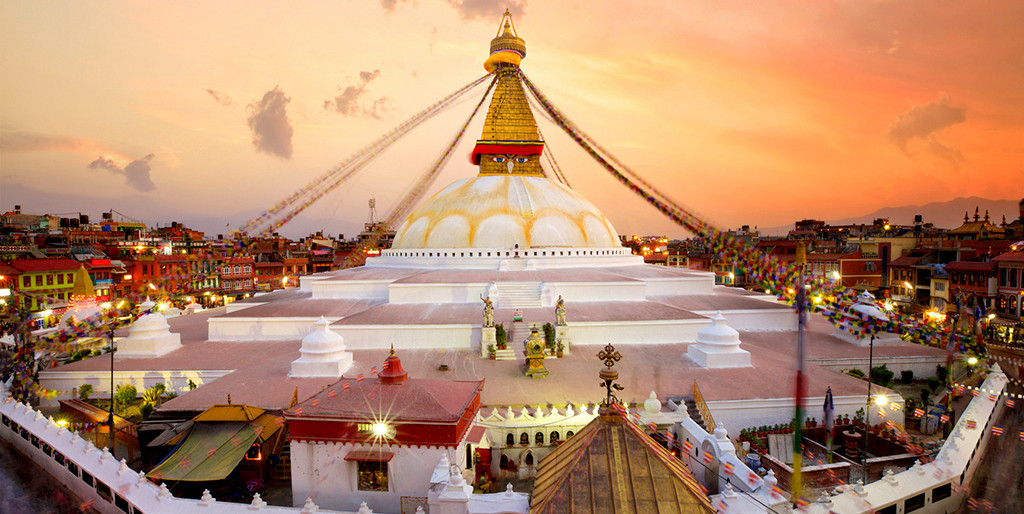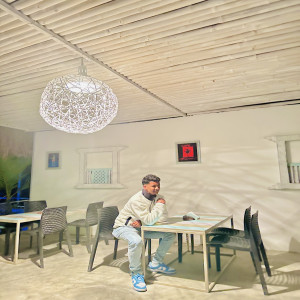Pashupatinath Temple, Kathmandu
Pashupatinath Temple in Kathmandu, Nepal, stands as one of the most sacred Hindu temples dedicated to Lord Shiva. It is revered not only by the people of Nepal but also by Hindus from different parts of the world. The temple's prominence stems from its religious significance and its location on the banks of the holy Bagmati River.
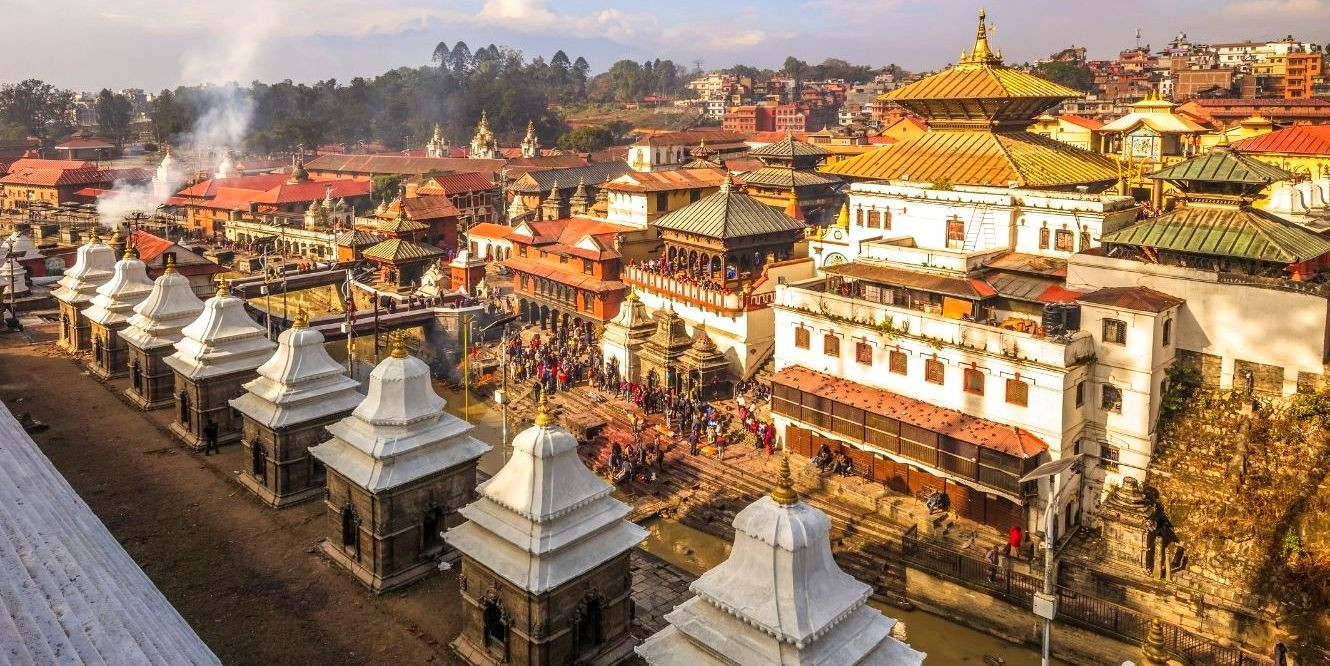
-
Historical and Religious Significance: The origins of Pashupatinath Temple date back to the 5th century, making it one of the oldest temples in Nepal. It is believed that the temple was constructed to protect the valley as it houses the lingam (phallic symbol of Shiva), which is considered a powerful protector. The site itself has been continuously inhabited and worshipped for thousands of years, even though the current structure dates to the 17th century after the original was destroyed by termites.
-
Architectural Splendour: The temple complex is a stunning example of Nepalese temple architecture, characterised by its pagoda-style design. The two-tiered golden roof and the silver-plated doors are particularly eye-catching. The entire complex is a sprawling collection of temples, ashrams, images, and inscriptions added over the centuries, contributing to its status as a UNESCO World Heritage Site.
-
Rituals and Festivities: Pashupatinath Temple is the focal point for many Hindu rituals, especially those related to the life cycle, such as birth, marriage, and death. The ghats (steps leading down to the river) are well-known for being a place where open-air cremations are performed, adhering to Hindu customs. These rituals are poignant and a profound experience for visitors, reflecting deep-seated beliefs about life, death, and rebirth.
-
Annual Festivals: One of the biggest events at Pashupatinath is Maha Shivaratri, the great night of Shiva, which attracts hundreds of thousands of devotees from across Nepal and India. During this festival, devotees fast, chant the holy name of Shiva, and maintain a night-long vigil.
-
Pilgrimage and Tourism: As a major pilgrimage destination, the temple draws not only religious devotees but also tourists interested in observing Hindu customs and rituals up close. The temple complex offers an immersive cultural experience, providing insight into the religious practices and daily lives of the Sadhus or holy men who reside there.
-
Visiting with Respect: Visitors to Pashupatinath Temple should be mindful of the sacred nature of the site. While the main temple is only accessible to Hindus, the surrounding complex is open to all, offering everyone a chance to witness the religious fervour and cultural richness of this extraordinary place.
Pashupatinath Temple embodies the spiritual heart of Nepal, making it a must-visit for those looking to understand the country's rich religious traditions and the deep devotion of its people.
Swayambhunath Stupa, Kathmandu
Swayambhunath Stupa, also affectionately known as the Monkey Temple due to its resident troop of monkeys, is one of the most iconic and revered landmarks in Kathmandu, Nepal. Perched on a hilltop and offering panoramic views of the city, this ancient religious complex is a symbol of peace and spirituality that attracts Buddhists, tourists, and scholars from around the world.
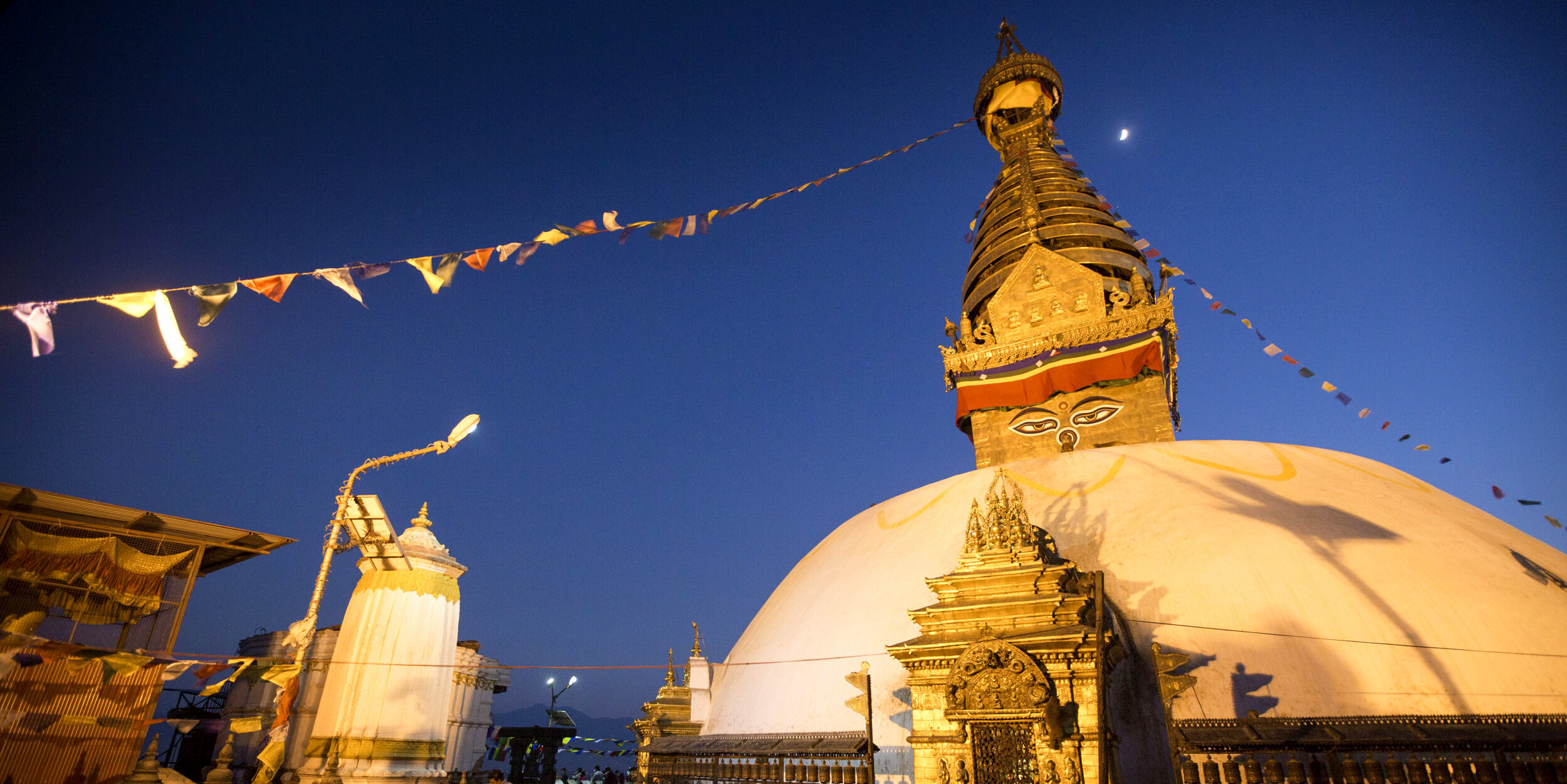
-
Historical and Cultural Significance: The origins of Swayambhunath are shrouded in myth and mystery, with legends dating it back to the beginnings of the Kathmandu Valley. According to folklore, the entire valley was once a lake, out of which grew a lotus when the valley was drained. The lotus flower is said to have transformed into the hill, and the stupa was later built on top of it. This stupa is one of the oldest of its kind in Nepal, with historical records suggesting it was already an important Buddhist pilgrimage destination by the 5th century A.D.
-
Architectural Features: Swayambhunath is a classic example of Buddhist stupa design, with a white dome at the base representing the earth, a cubical structure on top of the dome representing the elements, a conical spire representing fire, and a pinnacle representing the ether and the Buddha's crown. The eyes painted on each side of the spire symbolise the all-seeing eyes of the Buddha, overlooking the valley and spreading wisdom and peace. The stupa is adorned with colourful prayer flags that flutter in the wind, carrying mantras and prayers heavenward.
-
Religious Practices and Festivals: Swayambhunath is a vibrant centre of prayer and worship. Devotees walk around the stupa in a clockwise direction, spin prayer wheels, and chant mantras, particularly the famous Buddhist mantra "Om Mani Padme Hum." The stupa is especially bustling during Buddha Jayanti (the birthday of Buddha) and Losar (Tibetan New Year), when thousands of pilgrims gather to celebrate with lights, colours, and prayers.
-
Cultural and Tourist Attraction: The complex not only includes the main stupa but also a variety of shrines, temples, and monasteries, which are home to many important Buddhist relics and statues. These serve as a focal point for cultural and religious activities, and the site also offers insights into the syncretic nature of Nepalese spirituality, where Buddhism and Hinduism have intermingled over centuries.
-
Environmental and Panoramic Views: The hilltop location of Swayambhunath offers stunning views of Kathmandu and the surrounding valley. The climb up to the stupa is via a long staircase that is an integral part of the pilgrimage and tourist experience. The site is a peaceful oasis above the bustling city and provides a perfect spot for meditation and reflection.
Visiting Swayambhunath Stupa provides a deep understanding of Buddhist philosophy and the cultural heritage of Nepal. The stupa’s atmosphere of tranquility and its rich history make it a must-visit for anyone travelling to Kathmandu.
Boudhanath Stupa, Kathmandu
Boudhanath Stupa in Kathmandu is one of the largest and most significant stupas in the world, revered by both the local population and the international Buddhist community. This magnificent stupa stands as a beacon of Buddhist faith and culture, embodying peace and sanctity in the bustling city of Kathmandu.
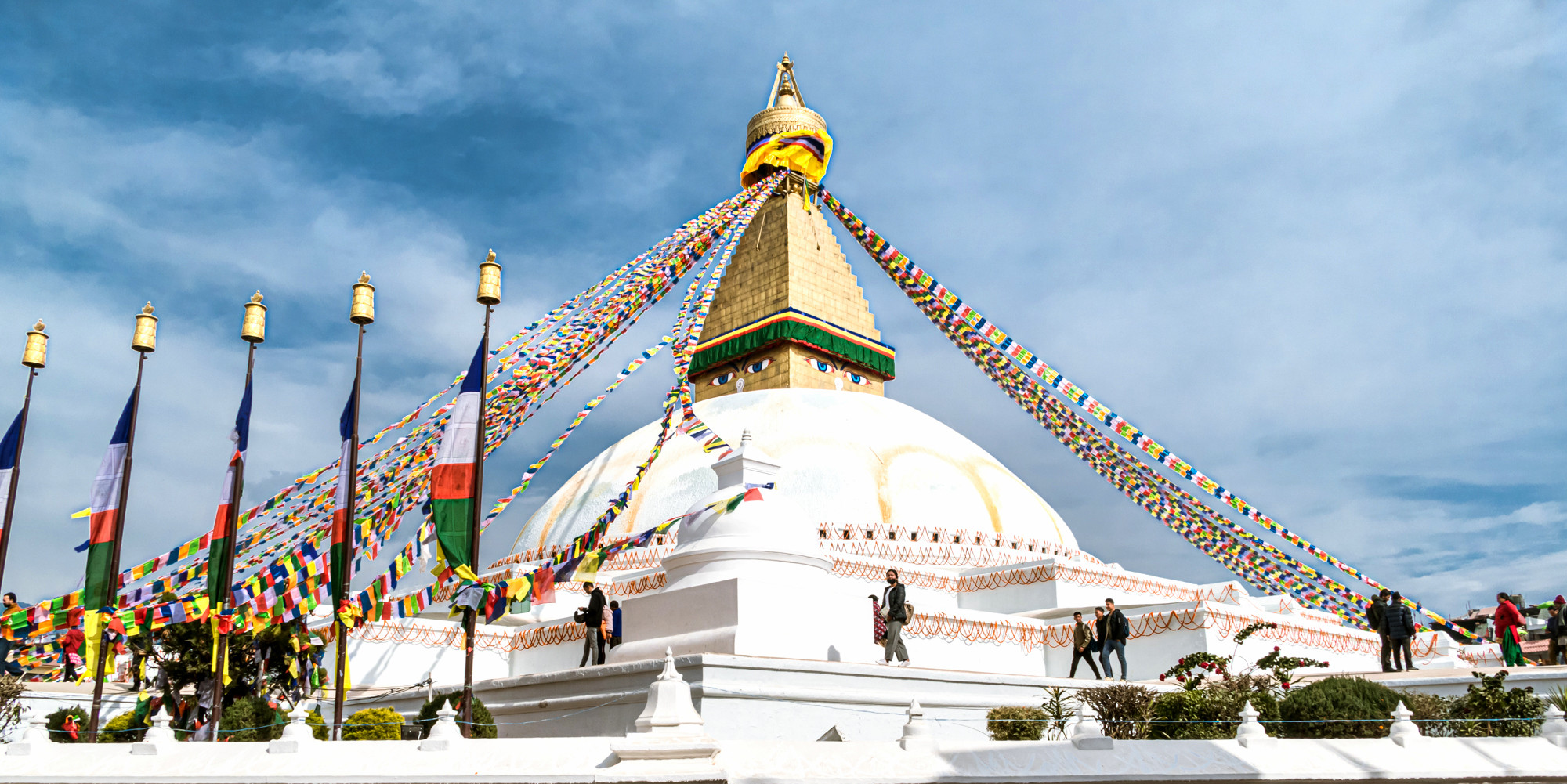
-
Historical and Cultural Significance: The origins of Boudhanath date back to the 5th century A.D., making it one of the oldest stupas in Nepal. According to legend, the stupa was constructed by an old woman who sought permission from the king to build a Buddhist shrine. The stupa has been an important centre of Buddhism since its inception and has been restored and embellished over the centuries, especially after significant damage during the 2015 earthquake.
-
Architectural Features: The stupa's massive mandala makes it one of the largest spherical stupas in Nepal and indeed in the world. The structure is notable for its giant dome, on top of which sits a square tower adorned with the omnipresent Buddha eyes on all four sides, symbolically surveying the four cardinal directions. These eyes are a distinctive feature of the stupa’s architecture, representing the all-seeing ability of the Buddha. The pyramid-shaped spire atop the tower is made up of thirteen steps, representing the path to enlightenment.
-
Religious Practices and Rituals: Boudhanath Stupa is a vital hub of Buddhist life and spirituality. It is especially important for the Tibetan exile community in Nepal. Pilgrims and visitors circumambulate the stupa in a clockwise direction, reciting mantras and spinning prayer wheels embedded in its base. The stupa is a key site for many Buddhist festivals, including Losar (Tibetan New Year) and Buddha Jayanti (the celebration of Buddha’s birth, enlightenment, and death), during which it is beautifully adorned with thousands of prayer flags and butter lamps.
-
Cultural and Tourist Attraction: The area surrounding the stupa is lined with monasteries and Tibetan shops selling religious art, thangkas, and handicrafts, making it a cultural as well as spiritual centre. The stupa’s environment is palpably tranquil, drawing visitors who seek a place for meditation, reflection, or simply to observe the devout practices of Buddhist followers.
-
Educational and Spiritual Experience: Visitors to Boudhanath Stupa can engage with the local community, learn about Tibetan Buddhism, and participate in guided meditation sessions offered by nearby monasteries. The site serves as an important educational resource for those interested in the principles of Buddhism and the lifestyle of its practitioners.
Boudhanath Stupa is not just a symbol of religious devotion; it is a living museum of Buddhist culture and a focal point for prayers, hopes, and dreams. Its historical significance, architectural grandeur, and spiritual atmosphere make it a must-visit destination for anyone travelling to Kathmandu, offering a peaceful escape from the hustle and bustle of city life.
Lumbini
Lumbini, the birthplace of Lord Buddha, is one of the most revered spiritual sites in the world, located in the Rupandehi District of Nepal. This UNESCO World Heritage site is not just a cornerstone of Buddhist faith but also a symbol of peace and spirituality that draws pilgrims and visitors from around the globe.
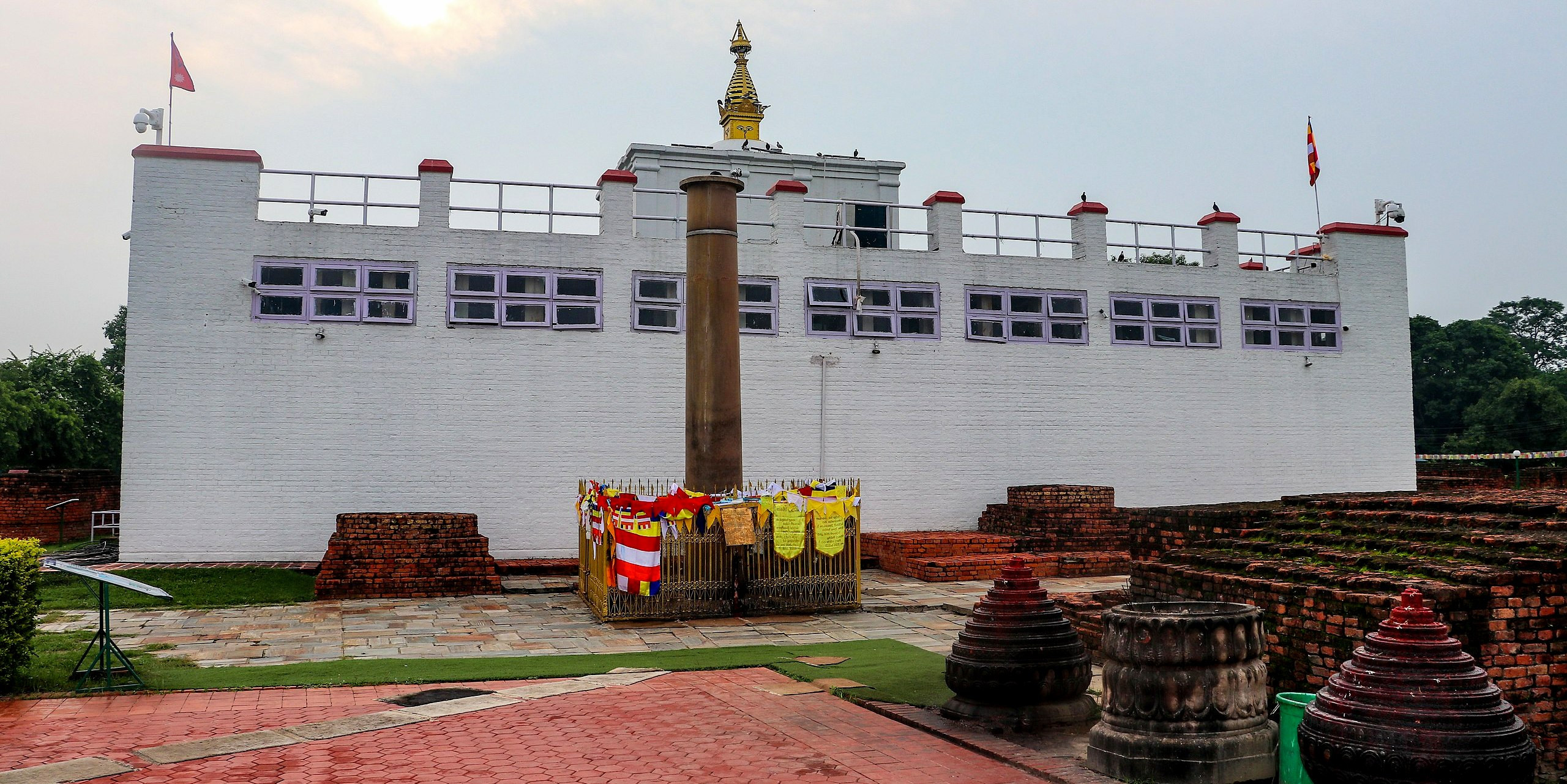
-
Historical Significance: Lumbini is recognised universally as the birthplace of Siddhartha Gautama, who achieved enlightenment and became Buddha. Historical records and archaeological findings confirm that Buddha was born here in 623 BC. The site holds immense historical and religious significance as it marks the beginning of the Buddhist faith and offers insights into the early life of its founder.
-
Sacred Sites and Monuments: The focal point of Lumbini is the Mayadevi Temple, which houses relics from the time of Buddha's birth, including stone markers that indicate the exact spot where Queen Mayadevi gave birth to Siddhartha. Adjacent to the temple is the sacred pond where it's believed Mayadevi took a bath before giving birth, and where Buddha had his first bath. Surrounding the temple are gardens and a series of monasteries built by different Buddhist nations. Each reflects its national style and architecture, contributing to the area’s rich cultural tapestry. These include the Chinese Monastery, the Royal Thai Buddhist Monastery, and the Myanmar Golden Temple, among others.
-
Archaeological Importance: Ongoing excavations and research in Lumbini continue to uncover artefacts and structures that date back to the Buddha's lifetime, providing valuable insights into the ancient Shakya kingdom and the early days of Buddhism. These findings help to deepen understanding of Buddhist teachings and the environment in which Buddha lived.
-
Spiritual and Educational Experience: Visiting Lumbini offers a profound spiritual experience, inviting reflection and meditation. The site is equipped with meditation centres where visitors can practice mindfulness and learn more about Buddhist teachings in a setting that is both inspiring and serene. Lumbini also serves as an educational site where scholars and practitioners can engage with the roots of Buddhism through conferences, seminars, and guided tours.
-
Tourism and Preservation: As a World Heritage site, Lumbini is protected under international laws that ensure its preservation for future generations. Efforts are continually made to maintain the sanctity of the site and enhance the visitor experience, making Lumbini not only a pilgrimage destination but also a significant cultural heritage site that showcases the peaceful teachings of Buddhism.
Lumbini transcends religious boundaries, offering a space for peace and reflection to people of all backgrounds. Its historical depth, combined with its spiritual offerings, makes it a must-visit destination for anyone interested in the origins of Buddhism or seeking a profound connection with spiritual history.
Muktinath Temple, Mustang
Muktinath Temple, situated in the Mustang district of Nepal, is a significant pilgrimage site revered by both Hindus and Buddhists. Nestled in the high Himalayas at an altitude of about 3,800 meters, this sacred temple offers not only spiritual solace but also breathtaking natural beauty.
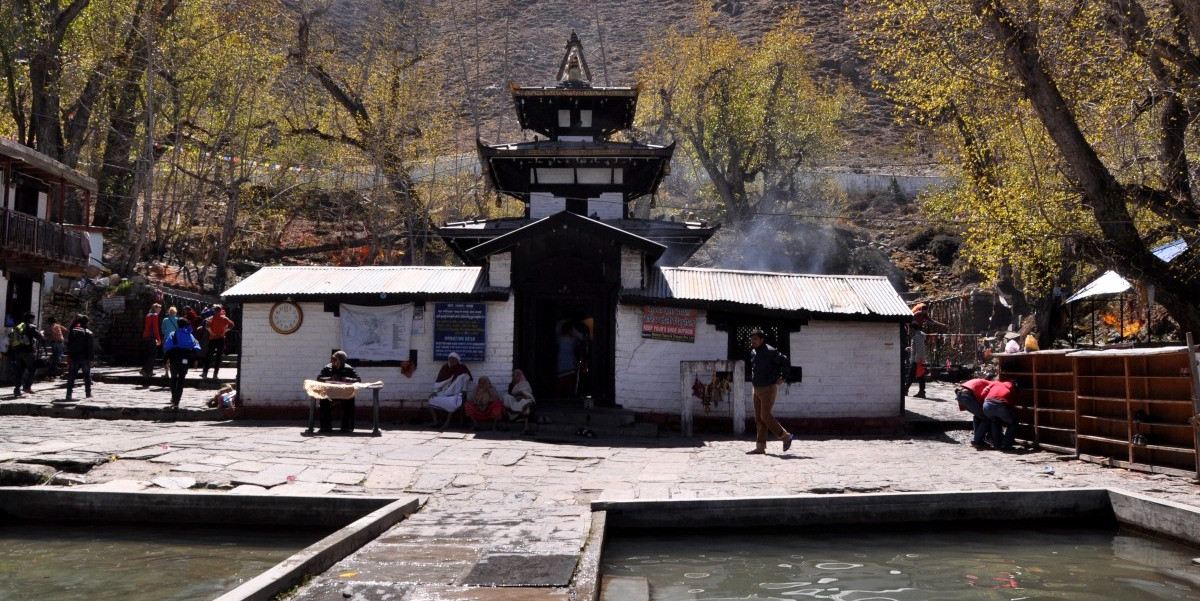
-
Religious and Cultural Significance: Muktinath, known as Mukti Kshetra (place of liberation), holds immense religious significance. For Hindus, it is one of the eight sacred places known as 'Svayam Vyakta Kshetras', and for Buddhists, it represents a place where Guru Rinpoche, the founder of Tibetan Buddhism, meditated. The temple is dedicated to Lord Vishnu and also houses statues of several other deities, creating a syncretic environment where elements of both religions are intertwined.
-
Architectural Features: The main shrine of Muktinath is a pagoda-style temple dedicated to Lord Vishnu. Surrounding the temple are 108 bull-faced spouts, from which sacred water flows. Pilgrims perform a ritual of running beneath these spouts, believed to cleanse sins and bring salvation. Another notable feature is the eternal flame, or "Jwala Mai," which burns continuously from natural gas underground, representing the element of fire alongside earth, water, and air, which are symbolically present in the temple’s architecture and rituals.
-
Pilgrimage and Rituals: Muktinath is a key site in the Annapurna Circuit trek, making it accessible to both trekkers and pilgrims. The journey to Muktinath itself is considered a pilgrimage, with the arduous trek symbolising the path to enlightenment. Visitors often partake in rituals like bathing in the sacred waters and lighting butter lamps, engaging deeply with the temple's spiritual practices.
-
Environmental Setting: Set against the backdrop of the majestic Himalayan mountains, Muktinath offers stunning landscapes and a serene environment that enhances the spiritual experience. The area around Muktinath includes barren, rocky hills and patches of lush greenery, reflecting the ecological diversity of the Mustang region.
-
Cultural Interactions: The temple area is also a cultural hub where traditions of the local Bhotiya and Tibetan communities are observed. During festivals, such as the famous Janai Purnima, the cultural and religious fervour is palpable, with rituals and celebrations that draw both locals and tourists.
-
Visitor Experience: Travelling to Muktinath Temple involves a combination of trekking and pilgrimage, providing a unique blend of physical challenge and spiritual enrichment. For those unable to undertake the trek, helicopter services are available from major cities like Pokhara and Kathmandu, making the sacred site accessible to a broader audience.
Muktinath Temple remains not just a destination for religious pilgrimage but a place of universal appeal, offering peace, solace, and a chance to witness the harmonious coexistence of different religious beliefs. Its sacred atmosphere and stunning natural surroundings make it a must-visit for anyone seeking spiritual growth or a deeper understanding of Nepal's cultural and religious landscape.
Manakamana Temple
Manakamana Temple in Nepal is a highly revered Hindu pilgrimage site located in the Gorkha District. It is dedicated to the Goddess Bhagwati, an incarnation of Parvati, the consort of Lord Shiva. The temple is perched on a 1,302-meter-high hill in the Himalayan range and is accessible by a cable car, which offers spectacular views of the Trisuli and Marshyangdi river valleys.
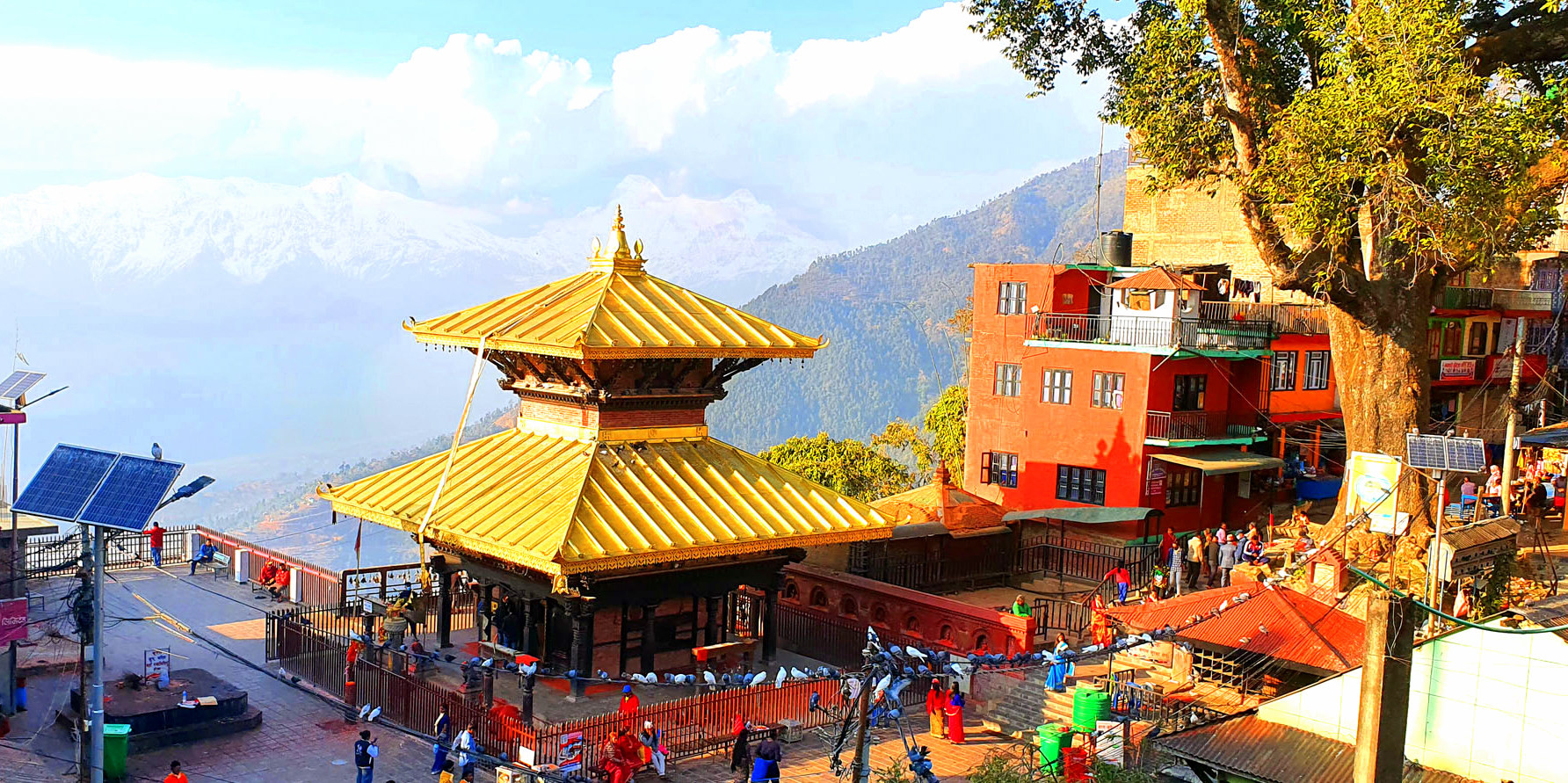
-
Historical and Cultural Significance: The name "Manakamana" derives from two words: "mana" meaning heart or soul, and "kamana" meaning wish. It is believed that Goddess Bhagwati grants the wishes of all who make the pilgrimage to her shrine to worship her with a pure heart. The tradition is rooted in a legend that dates back to the 17th century, involving the queen of the Gorkha king and her divine revelation.
-
Architectural Features: The Manakamana Temple showcases the traditional pagoda style of Nepalese architecture. It is a simple, yet striking structure made primarily from wood and tile, without the extensive carvings seen in many other Hindu temples. The temple was rebuilt after being damaged during the 2015 earthquake, maintaining its historical integrity and significance.
-
Rituals and Practices: Devotees visit the temple mainly to make offerings and seek blessings for the fulfilment of their desires. Common offerings include flowers, fruits, red cloth, and, traditionally, sacrifices of goats or pigeons, especially on Saturdays. The atmosphere is especially vibrant during the Dashain festival when large numbers of devotees visit.
-
Cable Car Journey: One of the highlights of visiting the Manakamana Temple is the cable car ride from Kurintar, which was the first of its kind in Nepal. The cable car travels over 2.8 kilometres and provides breathtaking views of the surrounding mountains and valleys, making the journey to the temple as memorable as the visit itself.
-
Cultural and Tourist Attraction: Beyond its religious importance, Manakamana is a cultural focal point, providing insights into the living traditions and beliefs of the Nepali people. The temple area is also surrounded by small shops selling local handicrafts, religious artefacts, and snacks, contributing to a lively market atmosphere.
-
Visitor Experience: Travellers to Manakamana Temple can enjoy not only the spiritual and religious aspects but also the natural beauty of the region. The journey to the temple, whether by foot along the traditional pilgrim path or by cable car, is an integral part of the pilgrimage and offers a unique cultural experience.
Manakamana Temple stands as a testament to the deep spirituality and rich cultural heritage of Nepal, attracting both devotees and tourists with its beautiful location, intriguing history, and the heartfelt faith of its visitors.
Janaki Mandir, Janakpur
Janaki Mandir, located in the heart of Janakpur in the Dhanusha district of Nepal, is a unique and culturally significant Hindu temple dedicated to Goddess Sita. Known as the "Naulakha Mandir" due to the cost of its construction—nine lakh rupees—this temple stands not only as a place of worship but also as a monument to divine love and devotion between Sita and her consort, Lord Rama.
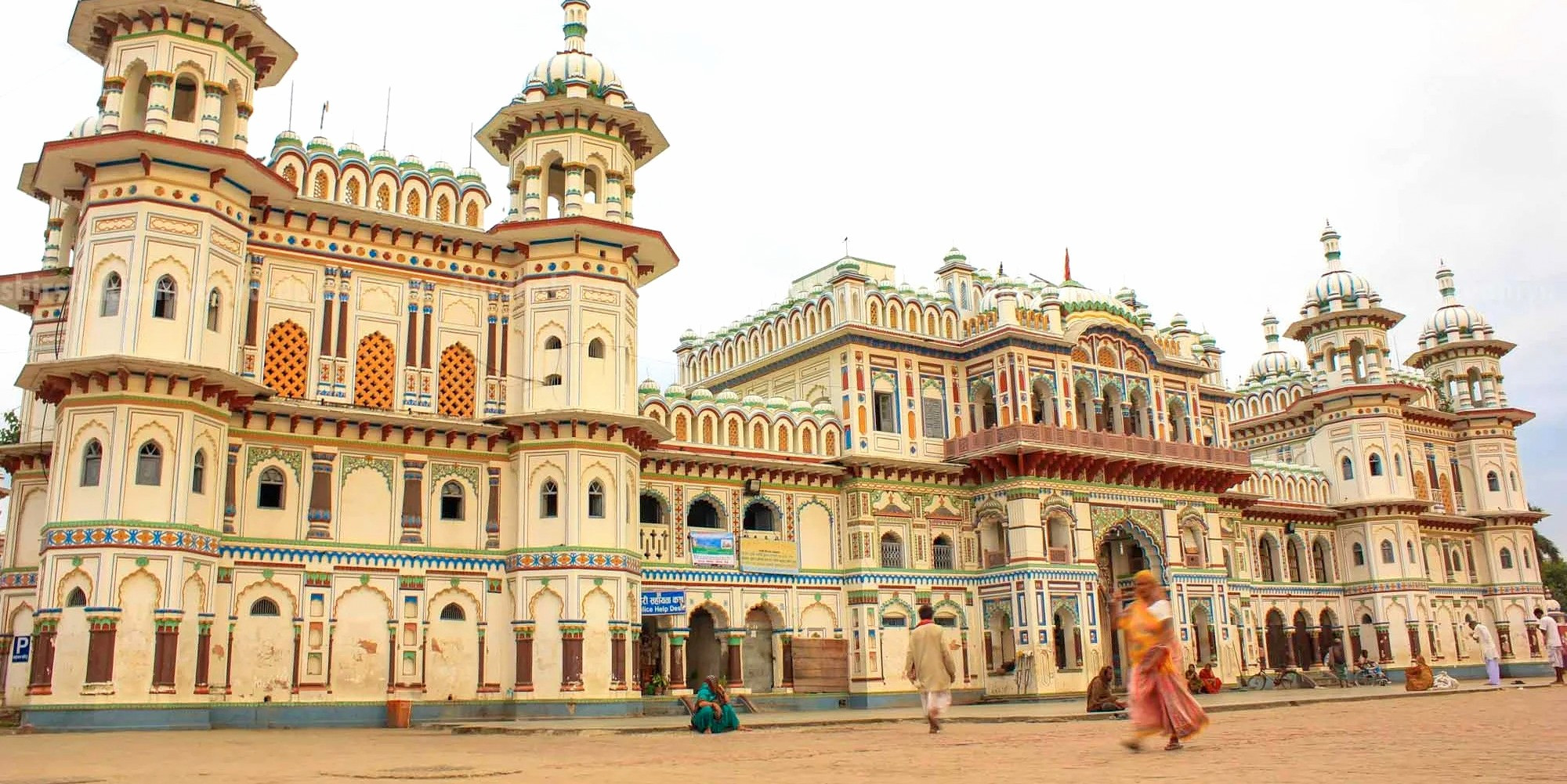
-
Historical and Cultural Significance: The temple's history is deeply intertwined with the epic tale of the Ramayana. Janakpur is celebrated as the birthplace of Goddess Sita and the site of her marriage to Lord Rama, making it a critical location in Hindu mythology. Janaki Mandir was built in 1910 by Queen Brisabhanu Kunwari of Tikamgarh and is an exemplary piece of Rajput architecture with Mughal influences, reflecting the grandeur of an ancient palatial structure.
-
Architectural Splendour: The temple's architecture is striking, with bright white walls and intricate carvings that cover its surface. It features a blend of Indian and Nepali architectural styles, with towering domes, arched windows, and a courtyard that holds a sacred pond known as the Vivah Mandap. This pond marks the spot where Rama and Sita were married, making it a focal point during festivities.
-
Religious Practices and Festivals: Janaki Mandir is the epicentre of vibrant Hindu festivals, most notably Vivaha Panchami, the anniversary of Rama and Sita’s marriage. During this festival, the temple and the city of Janakpur are adorned with decorations, and a grand procession reenacting the wedding is held, attracting thousands of pilgrims from India and Nepal. The temple also hosts other significant events such as Ram Navami and Chhath Puja, which draw devotees in large numbers.
-
Pilgrimage and Devotion: As a major pilgrimage site, Janaki Mandir not only serves the spiritual needs of the local population but also attracts devotees from across the globe. Visitors come to pay homage to Sita, offering prayers and seeking blessings. The temple’s atmosphere is imbued with devotion, and the air often carries the sound of bhajans and aartis, enhancing the spiritual experience.
-
Cultural Integration: The temple also plays a crucial role in promoting the cultural heritage of the Mithila region, which is known for its distinct art, music, and traditions. Mithila art, characterised by intricate patterns and vibrant colours, is prominently displayed throughout Janakpur, and the temple often serves as a venue for cultural exhibitions and performances.
-
Visitor Experience: Visiting Janaki Mandir offers a unique cultural immersion into the world of Hindu mythology and the traditions of the Mithila region. The temple is not only a site for religious devotion but also a place for historical exploration and cultural appreciation. Its welcoming atmosphere and the warmth of the local people make it a memorable destination for all who visit.
Janaki Mandir stands as a testament to the enduring legacy of Goddess Sita and the cultural richness of Janakpur, making it a must-visit for anyone interested in exploring the spiritual landscapes of Nepal.
Dakshinkali Temple, Kathmandu
Dakshinkali Temple, situated just outside of Kathmandu, Nepal, is dedicated to the fierce and powerful goddess Kali. It is one of the most significant temples for Hindu devotees, particularly those following Shakta tantrism, which emphasises the worship of female deities. The temple's secluded location amid a lush forested valley adds an air of mystery and solemnity, making it a unique place for worship and contemplation.
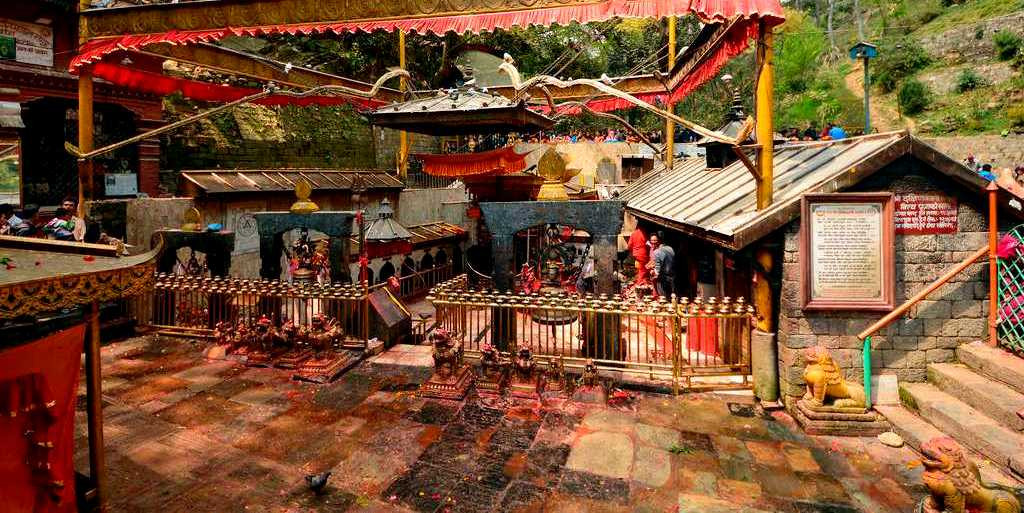
-
Religious Significance: The temple is named after Dakshin Kali, meaning the 'Kali of the south.' Goddess Kali is revered as a destroyer of evil and a protector who demands respect and devotion. The worship at Dakshinkali Temple involves complex rituals and offerings, which are believed to appease the goddess and bring blessings to her devotees. This temple is particularly famous for its practice of animal sacrifices, a traditional ritual performed to please the goddess.
-
Rituals and Practices: Animal sacrifices, primarily of chickens and goats, are a significant part of the rituals conducted at Dakshinkali Temple, especially during the Dashain festival, which falls in September or October each year. These offerings are made twice a week, on Tuesdays and Saturdays, which are considered auspicious days for worshipping Kali. Devotees gather in large numbers to participate in these rituals, seeking protection and the fulfilment of their wishes.
-
Architectural Features: The temple itself is modest yet vibrant, with statues and carvings of Goddess Kali and other deities associated with her. The architecture reflects traditional Nepalese styles, with a focus on the religious purpose rather than grandeur. The setting of the temple, surrounded by steep hills and dense forests, enhances its mystical and austere atmosphere, drawing worshippers into a profound spiritual experience.
-
Cultural Context: Visiting Dakshinkali Temple provides insight into the deeper aspects of Hindu spirituality and the cultural practices surrounding goddess worship in Nepal. The rituals performed here are intense and vivid, reflecting ancient traditions that have been preserved over centuries. For many, these rituals are an essential aspect of their faith and community life.
-
Visitor Experience: Travellers visiting Dakshinkali Temple should be prepared for a raw and authentic cultural experience. It is important for visitors to approach with respect and sensitivity, especially during ritual times when the local community is engaged in deeply personal and spiritual acts. The journey to the temple also offers a scenic escape from the hustle and bustle of Kathmandu, with the lush surroundings providing a tranquil backdrop.
-
Ethical Considerations: For those interested in visiting Dakshinkali Temple, it's crucial to be aware of and respectful towards the practices of animal sacrifice. While it may be challenging for some to witness, these rituals are a significant part of the local religious practice and cultural heritage.
Dakshinkali Temple stands out as a profound place of worship that offers a deeper understanding of Nepalese religious practices and the cultural significance of goddess worship. It is a destination that challenges and enriches, making it a compelling site for those interested in exploring the spiritual diversity of Nepal.
Rules and Regulations for Religious Places of Nepal to Visit
When visiting religious places in Nepal, it's important to respect the local customs and traditions that are deeply ingrained in the country's cultural fabric. Here are some key rules and regulations to keep in mind to ensure a respectful and enriching experience:
Dress Code
-
Modesty is crucial: Visitors should wear clothes that cover their shoulders and knees. Loose-fitting trousers or long skirts and tops that cover the shoulders are advisable. This is particularly important in Hindu temples and Buddhist monasteries.
-
Remove shoes: It is customary to remove shoes before entering temple premises or certain sacred areas. Look for signs or observe what locals do, and follow accordingly.
Conduct
-
Silence is golden: Many religious sites are places of worship, so it's important to speak softly and maintain a quiet demeanour.
-
No public displays of affection: Public displays of affection are frowned upon, especially within religious or sacred sites.
-
Follow photography rules: Always look for signs or ask permission before taking photos. Some temples prohibit photography inside the main worship area.
-
Observe prayer rituals from a distance: Avoid interrupting or joining religious ceremonies unless explicitly invited by the practitioners.
Sacred Objects and Symbols
-
Do not touch sacred objects: This includes religious artefacts, statues, or the walls of the temple or monastery.
-
Circumambulate in the correct direction: In Buddhist sites, always walk clockwise around stupas, chortens, or prayer wheels; in Hindu temples, follow the flow or direction indicated for darshan (viewing of the deity).
Offerings and Donations
-
Handling of offerings: If you wish to make an offering, ensure that it is appropriate for the site. Flowers and fruit are commonly acceptable, but it's best to watch what others are offering or ask a local for guidance.
-
Accept prasad gracefully: If offered prasad (blessed food) after a ceremony, accept it with both hands as a sign of respect.
Environmental Respect
-
Keep the site clean: Do not litter. Always look for designated disposal bins for offerings like flowers or food remnants.
-
Respect wildlife: Particularly in places like Swayambhunath (Monkey Temple), it's important to respect the animals' space and not feed or provoke them.
Special Considerations
-
Restricted areas: Some areas within temples might be off-limits to non-Hindus or foreigners. Respect these restrictions and enjoy the accessible parts of the site.
-
Participation in rituals: Participating in local rituals can be a profound experience, but do so only if you understand what the ritual involves and you have been invited to participate.
General Tips
-
Learn about the place before visiting: Understanding the historical and cultural significance can enhance your visit and help you appreciate the religious practices observed.
-
Seek guidance: When in doubt, it’s advisable to follow the lead of locals or ask for guidance from temple authorities or your tour guide.
By adhering to these rules and regulations, you contribute to preserving the sanctity and the cultural integrity of Nepal’s religious sites, ensuring a respectful and memorable experience for yourself and other visitors.
Discovering the spiritual legacy of Nepal through its religious sites is a great trip. Sites like Pashupatinath Temple and Lumbini provide more than just historical knowledge; they offer a great link to the customs and rites that define Nepalese society. Apart from being places of worship, these holy sites are also active centers of community and spirituality. Respectful interaction with these sites offers guests a different view of Nepal's rich cultural tapestry and an enriching experience that transcends conventional tourism. A trip to Nepal's spiritual sites is an amazing encounter with the essence of its people and their beliefs whether inspired by faith, inquiry, or beauty-seeking.
FAQs for Religious Places of Nepal to Visit
Q: What should I wear when visiting religious sites in Nepal?
A: Dress modestly. Cover shoulders and knees; loose-fitting pants or long skirts and shirts with sleeves are recommended. Remove your shoes before entering the temple premises.
Q: Are there any restrictions on who can enter the temples?
A: Some temples, particularly Hindu temples like Pashupatinath, restrict entry to non-Hindus. Check signage or ask locally for specific entry restrictions at each site.
Q: Can I take photos inside the temples?
A: Photography is often restricted inside the main worship areas. Always look for signs indicating photography rules or ask permission from the temple authorities.
Q: What is the best time to visit religious sites in Nepal?
A: The best time to visit is during the cooler months from September to November. However, visiting during festival times like Maha Shivaratri at Pashupatinath or Buddha Jayanti at Swayambhunath can be particularly rewarding.
Q: Are there specific rituals I can participate in?
A: Participation depends on the site and the occasion. Often, you can join in lighting butter lamps or spinning prayer wheels. Always follow the lead of locals or ask for guidance.
Q: How should I behave at these religious sites?
A: Be respectful: speak softly, keep the site clean, avoid public displays of affection, and maintain a general demeanour of reverence.
Q: What should I bring to the temples?
A: Apart from culturally appropriate clothing, consider bringing a small offering like flowers or fruit if you wish to participate in rituals. Also, small cash donations for temple maintenance are common and appreciated.
Q: Is it necessary to hire a guide for visiting religious sites in Nepal?
A: While not mandatory, hiring a guide can enhance your visit by providing insights into the historical and cultural contexts of the sites. Guides can also help in facilitating interactions with locals and participating in rituals.
Q: Can I buy souvenirs at these religious sites?
A: Many religious sites have nearby markets selling religious artefacts, souvenirs, and local handicrafts. Purchasing these can be a good way to support the local economy, but ensure the items are not religiously sensitive or restricted.
Q: How can I ensure that I respect the local culture and religion during my visit?
A: Educate yourself about the local customs and religious practices before your visit, observe and follow the behaviours of local worshippers, and show openness and respect for local traditions and beliefs.
For the Nepal tour, please click here.
If you are looking for different kinds of Nepal Tours or Trekking Packages, feel free to contact us.
